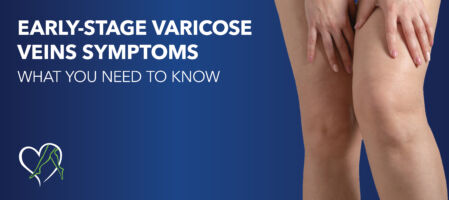
Identifying varicose vein symptoms is crucial for timely intervention, as early treatment can prevent the condition from worsening, alleviate discomfort, and reduce the risk of complications, including blood clots and chronic venous insufficiency.
Varicose veins are a common condition that affects millions of people worldwide. While they can appear at any stage of life, they often develop over time, progressing through various stages. Recognizing the early-stage varicose veins symptoms is crucial for timely intervention and effective management. In this blog, we will explore the signs of varicose veins in their initial phases and why addressing them early is essential.
Before diving into the early symptoms, let's briefly understand what varicose veins are. Varicose veins are enlarged, twisted, and often painful veins commonly occurring in the legs. They develop when the one-way valves in your veins, which are responsible for directing blood flow back to the heart, become weakened or damaged.
Called chronic venous insufficiency or vein disease, the inability to send blood back upward towards the heart against gravity causes blood to pool downward in the veins of the lower limbs, leading to the characteristic bulging, rope-like appearance of affected veins.
Young people can develop varicose veins, although they are more commonly associated with aging. Factors like genetics, obesity, hormonal changes, and prolonged periods of sitting or standing can contribute to their development at a younger age. While the prevalence tends to increase with age, individuals of all ages need to be aware of risk factors and early symptoms and seek medical advice if varicose veins are a concern.
Visible Veins
The earliest sign of varicose veins is often the appearance of visible, twisted veins just beneath the skin's surface. These veins may have a bluish or purplish hue and resemble a twisted cord or rope. You may notice them on your legs, usually around the calf or thigh area. In the early stages, these veins are generally smaller and less prominent than in later stages.
Leg Discomfort
People with early-stage varicose veins may experience mild discomfort in their legs. This discomfort is often described as aching or heaviness and tends to worsen after prolonged periods of standing or sitting. Paying attention to these sensations is essential, as they can be early warning signs of vein issues.
Itching and Burning
Itching and burning sensations on the skin overlying the affected veins are also common early symptoms. This can be caused by the increased pressure and pooling of blood in the veins. Scratching these areas can lead to skin irritation and, in some cases, open sores (ulcers).
Swelling
Early-stage varicose veins may lead to mild swelling, primarily around the ankles and lower legs. This swelling can be more pronounced at the end of the day and may improve with leg elevation. It's important to distinguish this swelling from other medical conditions that can cause similar symptoms.
Cramping
Some individuals with early-stage varicose veins may experience occasional muscle cramps, especially at night. These cramps can be uncomfortable and may result from reduced circulation and increased pressure in the affected veins.
Restless Legs
Restless Leg Syndrome (RLS) is a condition characterized by an irresistible urge to move the legs, often due to discomfort or tingling sensations. Early-stage varicose veins may contribute to developing or exacerbating RLS symptoms, making it challenging to sit still or sleep comfortably.
Skin Changes
As varicose veins progress, the skin overlying the affected veins can undergo changes. You may notice a slight discoloration in the early stages, often called "venous eczema." The skin may appear red, brown, or discolored, indicating poor circulation in the area.
Identifying early symptoms of varicose veins is essential for several reasons:
Preventing progression: Addressing varicose veins in their early stages can prevent them from worsening over time. Early intervention can help slow down the progression of the condition and reduce the risk of complications.
Managing discomfort: Treating varicose veins early can alleviate discomfort and pain associated with the condition. Managing symptoms early can lead to a better quality of life.
Preventing complications: Left untreated, varicose veins can lead to complications such as blood clots, skin ulcers, and chronic venous insufficiency. Early treatment can help prevent these more severe issues.
Cosmetic concerns: Many individuals seek treatment for varicose veins in their early stages due to cosmetic concerns. Addressing them early can help maintain the appearance of your legs.
Improved blood flow: Treating varicose veins can improve blood circulation in the legs, reducing the risk of other circulatory problems.
If you suspect you have early-stage varicose veins or are experiencing any of the mentioned symptoms, it's crucial to take action. Here are some steps to consider:
Recognizing and addressing early-stage varicose veins symptoms is vital for maintaining overall health and quality of life. Timely intervention can prevent the progression of the condition, alleviate discomfort, and reduce the risk of complications.
Early action can lead to healthier and happier legs! If you suspect you have varicose veins, don't hesitate to consult Center for Vein Restoration to discuss your symptoms and explore treatment options. CVR accepts many insurances, including Aetna, Amerigroup, Anthem, Blue Cross/Blue Shield, Cigna, MultiPlan, Medicaid, Medicare, and more.
Call 240-965-3915 to speak to a Patient Services Representative or schedule your consultation online at a CVR near you today.
